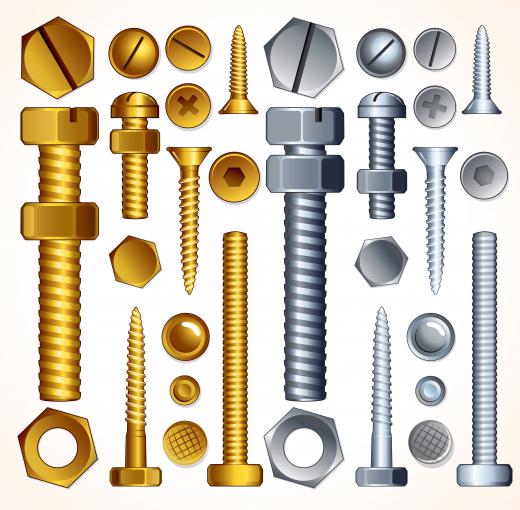At AboutMechanics, we're committed to delivering accurate, trustworthy information. Our expert-authored content is rigorously fact-checked and sourced from credible authorities. Discover how we uphold the highest standards in providing you with reliable knowledge.
What are Locking Fasteners?
Locking fasteners are typically nuts that lock onto the threads of a bolt when tightened and prevent loosening. Often the nuts utilize a special thread that grips onto a bolt, but some nuts use a system that incorporates an added piece that wedges itself against an object and prevents the nut from turning until it has been removed. Certain types of locking fasteners utilize a chemical compound within the nut's threads that is heated from the friction of tightening the assembly. This heat activates the chemical, creating a glue that bonds the nut to the bolt.
The problem with nuts and bolts is that they typically loosen after being installed. Movement in the materials that they are installed in will cause the nut to back off in time. A loose bolt assembly can cause catastrophic failure in whatever it is installed in. Loose bolts can flex and break, allowing them to drop into moving parts where they break or jam a machine and cause it to lock up or seize. Once a bolt breaks, it can allow a part its holding to simply fall out of place and be damaged or lost.

Locking fasteners into place with safety wire is a time consuming method of assuring a bolt remains tight and in place. This is a procedure that works well, but it is difficult to remove the assembly in an expedient manner. Locking fasteners in place using spring lock washers has proven to fail over time and some studies show that the spring washer itself tends to loosen the nut when severe vibration is present. Modern locking fasteners prevent this from occurring and maintain the integrity of the bolt.
Lock nuts are the most common of the locking fasteners and perhaps the easiest to use. A lock nut comes in two varieties, the standard steel lock nut which uses a row of distorted threads which cause the nut to be torqued into holding when tightened, and the nylon lock nut commonly referred to as a Nylock Nut. This nut uses a nylon insert at the top of the nut that is smaller than the threads of the bolt, this nylon fixture is forced over the bolt as the nut is tightened, causing the nut to be wedged into place.
Some locking fasteners use an oblong piece of metal which fits over the hex shape of the nut and is wedged against the side of the materials being bolted together. This type of locking fastener is best suited for custom automotive exhaust and header applications. Perhaps the simplest form of the locking fasteners is a nut with a built-in washer. The washer has small teeth machined into it which cut into the material it is tightened against, thereby preventing it from backing out.
AS FEATURED ON:
AS FEATURED ON:











Discuss this Article
Post your comments